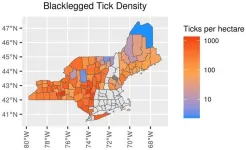(Press-News.org) The proportion of babies dying before and during labor after 41 weeks of gestation has fallen by 47% in Sweden in a relatively short time. This is the result of a major national study. The reduction has occurred since the procedures around induction have changed.
A pregnancy normally lasts around 40 weeks. However, a fairly high proportion of women, 22%, pass their due date and are pregnant for 41 weeks or longer. Although Sweden generally has a very low risk of stillbirth and death within the first month of life, the risk increases the longer the pregnancy continues past 41 weeks of gestation. The question that then arises is whether the woman should be induced.
The current study, published in the journal PLOS Medicine, is based on registry data on more than 150,000 births in Sweden where the women were one week or more after the expected date of delivery.
The aim was to investigate how infant mortality and morbidity in late-term births have changed since 2020, when most maternity hospitals in the country changed their practices for induction.
The new procedures were a response to research findings from 2019 that showed that fewer infants died if women were induced as early as after 41 gestational weeks, compared to 42, which was the standard practice at the time. The shift in 2020 meant a more active management where women began to be offered induction at 41 weeks or individual assessment of whether induction was needed.
Risk almost halved
When the researchers now compare the periods 2017-2019 and 2020-2023 (until September 2023 (incl.)), the results show a 47% decrease in the proportion of stillbirths or infants dying within four weeks. In the first period, 124 infants (1.7 per 1 000) and in the second period 74 infants (0.9 per 1 000) died during labor after 41 gestational weeks or more. The periods covered approximately the same number of these births.
The study also shows that a composite measure of mortality and severe morbidity in the neonatal period was lower in the latter group, after 2020. At the same time, there was a slight increase in the rate of emergency caesarean sections, but the rate of caesarean sections increased even more in gestational week 39-40.
Researchers are unable to determine exactly which interventions led to the improved survival of the children. It is therefore unclear whether this is mainly due to routine induction after 41 gestational weeks or whether intensive monitoring is sufficient to select women who should be recommended for induction.
One of the driving forces behind the study is Karin Källén, Statistician and Professor of Clinical Epidemiology in Obstetrics and Gynecology at Lund University:
“The results show a clear decrease in both neonatal death and severe morbidity and an increase in the number of inductions and emergency cesarean sections. With around 22 000 women annually in Sweden still pregnant at 41 weeks, 18 infant deaths have been prevented annually, says Karin Källén.
Good scientific basis
Ulla-Britt Wennerholm is Adjunct Professor of Obstetrics and Gynecology at Sahlgrenska Academy, University of Gothenburg. She also had a major research role in SWEPIS (Swedish Postterm Induction Study), published in 2019, which led to the change in care routines.
“The present study gives support for a more active management with induction or individual assessment at 41 weeks. The difference between the pre- and post-2020 periods was large, but at the same time it is important to emphasize that the absolute risk to an individual woman and her baby is very small, regardless of whether the delivery takes place after 41 or 42 weeks,” she says.
The study in PLOS Medicine is based on data from the National Pregnancy Registry, the Swedish Neonatal Quality Registry and Statistics Sweden. The women included were at least one week overdue and had low-risk pregnancies in the sense that they were healthy, were expecting a baby in an occipito-anterior (head first) position and had not previously had a caesarean section.
END
Sharp drop in mortality after 41 weeks of pregnancy
2025-01-16
ELSE PRESS RELEASES FROM THIS DATE:
Flexible electronics integrated with paper-thin structure for use in space
2025-01-16
Being lightweight is essential for space structures, particularly for tools used on already small, lightweight satellites. The ability to perform multiple functions is a bonus. To address these characteristics in a new way, researchers at the University of Illinois Urbana-Champaign successfully integrated flexible electronics with a three-ply, self-deployable boom that weighs only about 20 grams.
“It's difficult to get commercial electronics integrated into these super thin structures,” said Xin Ning, an aerospace professor in The Grainger College of Engineering at U. of ...
Immune complex shaves stem cells to protect against cancer
2025-01-16
A group of immune proteins called the inflammasome can help prevent blood stem cells from becoming malignant by removing certain receptors from their surfaces and blocking cancer gene activity, according to a preclinical study by Weill Cornell Medicine investigators.
The study, published Jan. 2 in Nature Immunology, may lead to therapies that target the earliest stages of cancer. The findings bolster the idea that the inflammasome has a dual role—it promotes inflammation associated with poor outcomes in late cancer stages, but early on, it can help prevent cells from becoming cancerous in the first ...
In the Northeast, 50% of adult ticks carry Lyme disease carrying bacteria
2025-01-16
Across most of the Northeast, getting bitten by a blacklegged tick— also called a deer tick — is a risk during spring, summer, and fall. A new Dartmouth study, published in Parasites and Vectors, finds that 50% of adult blacklegged ticks carry the bacteria that causes Lyme disease while 20% to 25% of the younger (nymph) blacklegged ticks carry the bacteria.
A team of researchers from universities, health departments, and agricultural agencies from across the Northeast conducted a meta-analysis of data on how many blacklegged ticks there are and how many of them have the potential to pass pathogens ...
U of A Cancer Center clinical trial advances research in treatment of biliary tract cancers
2025-01-16
TUCSON, Arizona — The results of a clinical trial led by researchers at the University of Arizona Health Sciences and published in the Journal of Clinical Oncology showed that chemotherapy combining three different types of drugs did not improve overall survival for patients with advanced stage, inoperable biliary tract cancers.
“Biliary tract cancer is comparatively rare, but it’s aggressive and spreads fast. Our accrual of more than 450 patients in a little more than two years really shows there is a need for new ways to help people with biliary tract cancer,” ...
Highlighting the dangers of restricting discussions of structural racism
2025-01-16
PHILADELPHIA (January 16, 2025) – A new Health Affairs Health Policy Brief highlights the detrimental impact of recent state and federal policies that restrict discussions of “divisive concepts,” including structural racism. It warns that these policies undermine efforts to address health inequities and improve population health.
“By limiting discussions of structural racism, these policies ignore the historical and environmental factors that shape health outcomes,” said co-author Derek Griffith, PhD, the Risa Lavizzo-Mourey ...
NYU Tandon School of Engineering receives nearly $10 million from National Telecommunications and Information Administration
2025-01-16
NYU Tandon, collaborating institutions and industry partners have been awarded nearly $10 million to develop next generation communications technology.
The project, dubbed SALSA (Spectrally Agile Large-Scale Arrays), is funded by the U.S. Department of Commerce's National Telecommunications and Information Administration (NTIA) to advance U.S. leadership in open, secure communications infrastructure.
SALSA aims to create advanced wireless systems that operate in the "upper mid-band" spectrum — a region of frequencies relatively ...
NASA scientists find new human-caused shifts in global water cycle
2025-01-16
In a recently published paper, NASA scientists use nearly 20 years of observations to show that the global water cycle is shifting in unprecedented ways. The majority of those shifts are driven by activities such as agriculture and could have impacts on ecosystems and water management, especially in certain regions.
“We established with data assimilation that human intervention in the global water cycle is more significant than we thought,” said Sujay Kumar, a research scientist at NASA’s Goddard Space Flight Center in Greenbelt, Maryland, and a co-author ...
This tiny galaxy is answering some big questions
2025-01-16
Leo P, a small galaxy and a distant neighbor of the Milky Way, is lighting the way for astronomers to better understand star formation and how a galaxy grows.
In a study published in the Astrophysical Journal, a team of researchers led by Kristen McQuinn, a scientist at the Space Telescope Science Institute and an associate professor in the Department of Physics and Astronomy at the Rutgers University-New Brunswick School of Arts and Sciences, has reported finding that Leo P “reignited,” reactivating during a significant period on the timeline of the universe, producing stars when many other small galaxies didn’t.
By ...
Large and small galaxies may grow in ways more similar than expected
2025-01-16
A team of astronomers led by University of Arizona researcher Catherine Fielder has obtained the most detailed images of a small galaxy and its surroundings, revealing features typically associated with much larger galaxies. The observations provide a rare, elusive glimpse into how small galaxies form and evolve, suggesting that the mechanisms fueling galaxy growth may be more universal than previously thought.
Fielder presented the findings at the 245th meeting of the American Astronomical Society in National Harbor, Maryland, during a press briefing ...
The ins and outs of quinone carbon capture
2025-01-16
Carbon capture, or the isolation and removal of carbon dioxide from the atmosphere during industrial processes like cement mixing or steel production, is widely regarded as a key component of fighting climate change. Existing carbon capture technologies, such as amine scrubbing, are hard to deploy because they require significant energy to operate and involve corrosive compounds.
As a promising alternative, researchers from the Harvard John A. Paulson School of Engineering and Applied Sciences (SEAS) have developed carbon capture systems that use molecules called ...










